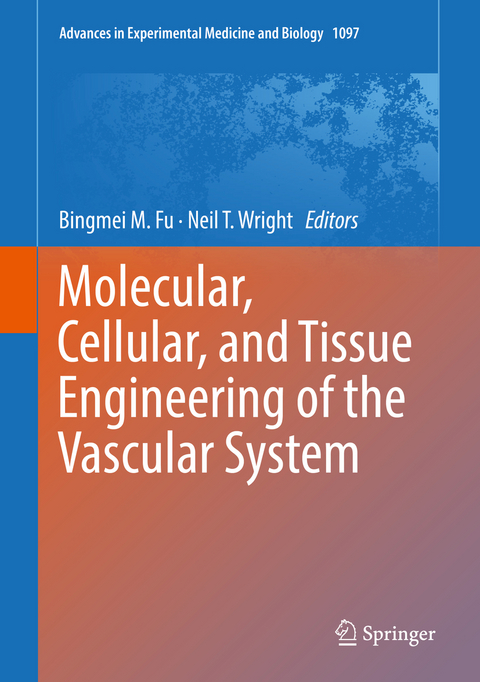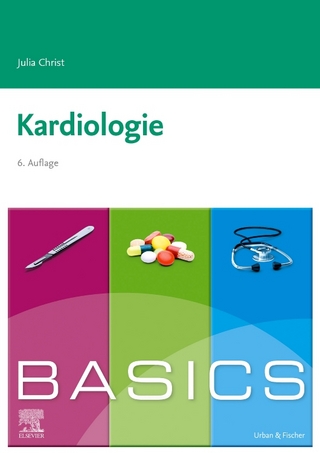
Molecular, Cellular, and Tissue Engineering of the Vascular System
Springer International Publishing (Verlag)
978-3-319-96444-7 (ISBN)
This book introduces the latest research in molecular, cellular, and tissue engineering of the vascular system. Topics covered include the roles of endothelial surface glycocalyx as a mechano-sensor and transducer for blood flow, a barrier to water and solute transport across the vascular wall and to the interaction between circulating cells and the vessel wall, the roles of nuclear envelope proteins and nuclear lamina in regulating vascular functions under blood flow-induced forces, and the roles of smooth muscle cells and extracellular components in arterial vasoconstriction. Other topics covered include non-surgical vascular interventions for coronary artery diseases, genesis and mechanisms of atherosclerotic plaque microcalcifications and human abdominal aortic aneurysms, experiments and modelling for red blood cell and tumor cell movement in microcirculation, transport across the blood-brain barrier and its role in Alzheimer's disease, mathematical models for cell survival after hyperthermia, application of hypothermia in enhancing treatment for brain and spinal cord injuries, and damage of eardrums due to blast waves. This is an ideal book for biomedical engineers and researchers, medical researchers, and students in biomedical engineering and medical sciences.
Bingmei M Fu is a Professor of Biomedical Engineering at The City College of the City University of New York. She received her BS and MS in Modern Mechanics from the University of Science and Technology of China, her Ph.D. in Mechanical Engineering from the City University of New York and her postdoctoral training in School of Medicine at the University of California, Davis. Prior to her appointment at City College, she was an Associate Professor in Mechanical Engineering at the University of Nevada, Las Vegas. She is a fellow of the American Institute for Medical and Biological Engineering and a member of the Biomedical Engineering Society and the American Association for the Advancement of Science. Her major research activities involve modelling nano and micro transport phenomena in the microcirculation, and corresponding in vivo animal and in vitro culture cell experiments. Neil T. Wright is an Associate Professor of Mechanical Engineering at Michigan State University. He received his BS in Engineering Science and Mechanics from Virginia Tech, his MS in Mechanical Engineering from the University of Colorado, and his PhD in Mechanical Engineering and Applied Mechanics from the University of Pennsylvania. Prior to his appointment at Michigan State, he was an Associate Professor at the University of Maryland, Baltimore County. He is a fellow of the American Society of Mechanical Engineers and a member of the Biomedical Engineering Society and the American Association for the Advancement of Science. His laboratory measures the thermophysical properties of biological materials and superconducting niobium.
Chapter 1: The Role of Endothelial Surface Glycocalyx in Mechanosensing and Transduction.- Chapter 2: The Molecular Structure Of The Endothelial Gycocalyx Layer (EGL) and Surface Layers (ESL) Modulation of Transvascular Exchange.- Chapter 3: Role of the Glycocalyx as a Barrier to Leukocyte-Endothelium Adhesion.- Chapter 4: Mechanobiology and Vascular Remodeling: from Membrane to Nucleus.- Chapter 5: Endothelial nuclear lamina in mechanotransduction under shear stress.- Chapter 6: Regional heterogeneity in the regulation of vasoconstriction in arteries and its role in vascular mechanics.- Chapter 7: Microcalcifications, their genesis, growth and biomechanical stability in fibrous cap rupture.- Chapter 8: Abdominal Aortic Aneurysm Pathomechanics: Current Understanding and Future Directions.- Chapter 9: Vascular intervention: from angioplasty to bioresorbable vascular scaffold.- Chapter 10: On the physics underlying longitudinal capillary recruitment.- Chapter 11: Tumor Metastasis in theMicrocirculation.- Chapter 12: Modelling Cell Adhesion and Extravasation in Microvascular system.- Chapter 13: Transport across the Blood-Brain Barrier.- Chapter 14: Blood-Brain Barrier Integrity and Clearance of Amyloid-beta from the BBB.- Chapter 15: Mathematical Models of Cell Response Following Heating.- Chapter 16: Hypothermia Used in Medical Applications for Brain and Spinal Cord Injury Patients.- Chapter 17: Biomechanical Changes of Tympanic Membrane to Blast Waves.
| Erscheinungsdatum | 28.10.2018 |
|---|---|
| Reihe/Serie | Advances in Experimental Medicine and Biology |
| Zusatzinfo | VIII, 334 p. 84 illus., 65 illus. in color. |
| Verlagsort | Cham |
| Sprache | englisch |
| Maße | 178 x 254 mm |
| Gewicht | 833 g |
| Themenwelt | Medizin / Pharmazie ► Medizinische Fachgebiete ► Biomedizin |
| Medizinische Fachgebiete ► Innere Medizin ► Kardiologie / Angiologie | |
| Medizin / Pharmazie ► Physiotherapie / Ergotherapie ► Orthopädie | |
| Naturwissenschaften ► Biologie ► Genetik / Molekularbiologie | |
| Naturwissenschaften ► Biologie ► Mikrobiologie / Immunologie | |
| Naturwissenschaften ► Biologie ► Zellbiologie | |
| Schlagworte | Abdominal Aortic Aneurysms • atherosclerotic plaque microcalcifications • blood-brain barrier • endothelial barrier water transport • endothelial surface glycocalyx barrier • endothelial surface glycocalyx mechanosensor • interactions circulation endothelial cells • mechanosensing mechanoregulation extracellular mat • mechanosensing mechanoregulation extracellular matrix • microvascular transport • models thermal regulation cell |
| ISBN-10 | 3-319-96444-5 / 3319964445 |
| ISBN-13 | 978-3-319-96444-7 / 9783319964447 |
| Zustand | Neuware |
| Haben Sie eine Frage zum Produkt? |
aus dem Bereich


